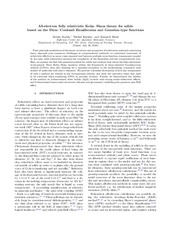| dc.contributor.advisor | Ruud, Kenneth | |
| dc.contributor.author | Kadek, Marius | |
| dc.date.accessioned | 2018-09-14T12:07:09Z | |
| dc.date.available | 2018-09-14T12:07:09Z | |
| dc.date.issued | 2018-08-28 | |
| dc.description.abstract | Effects arising from the special theory of relativity significantly influence
the electronic structure and properties of molecules and solid-state materials
containing heavy elements. At the same time, the inclusion of the relativistic
effects in theoretical and computational models increases their methodological
complexity and the computational cost. In the solid state, additional
challenges to the mathematical and algorithmic robustness of methods arise due
to the infinite extent of the systems.
In this thesis, I present two extensions of quantum-chemical relativistic
methods based on Gaussian-type basis functions in the study of the electronic
ground-state of molecules: band-structure calculations of materials in the
solid state, and simulations of the response of molecules that are subjected to
an external time-dependent field by propagating their perturbed state in real
time. The development of the relativistic methods for solids was preceded by an
independent implementation of the theory at the nonrelativistic level. In
comparison to methods based on plane waves, the use of Gaussian-type basis
functions in the solid-state community is limited. The relativistic method
presented here is the first ever implementation of the Dirac-type equations
using Gaussian-type basis functions for solid-state systems, and can be used to
study one-, two-, and three-dimensional periodic systems on an equal footing
for the entire periodic table. The time propagation method is a technically
simpler alternative to perturbation approaches, and is applied here to probe
relativistic effects on absorption and X-ray spectra, and nonlinear optical and
chiroptical properties of molecules. Our work in the both areas provides a
technology with the potential to predict properties of novel materials, and to
support the interpretation of experiments. | en_US |
| dc.description.doctoraltype | ph.d. | en_US |
| dc.description.popularabstract | Properties of molecules and materials range from how they reflect light, to how
they conduct electricity. Such properties we experience on a daily basis, but
they are, in fact, determined by the laws of quantum theory. However, correct
theoretical predictions of properties of materials containing heavy elements
requires incorporation of another of the fundamental physical theories, namely
the Einstein's theory of relativity. I have developed a method and a tool for
incorporating relativistic effects in the studies of the electronic structure
of materials, and the response of molecules to electric fields. Such a method
requires solving complicated quantum mechanical equations using a computer. The
method can support the interpretation of experiments, and has the potential to
predict properties of novel materials. | en_US |
| dc.description.sponsorship | Department of Chemistry | en_US |
| dc.description | <p>Paper I and III are not available in Munin<p>
<p>Paper I: Repisky, M., Konecny, L., Kadek, M., Komorovsky, S., Malkin, O.L., Malkin, V.G. & Ruud, K. (2015). Excitation Energies from Real-Time Propagation of the Four-Component Dirac–Kohn–Sham Equation. Available in <a href=https://doi.org/10.1021/ct501078d>Journal of Chemical Theory and Computation, 11(3), 980-991.</a><p>
<p>Paper III: Konecny, L., Kadek, M., Komorovsky, S., Malkina, O.L., Ruud, K. & Repisky, M. (2016). Acceleration of Relativistic Electron Dynamics by Means of X2C Transformation: Application to the Calculation of Nonlinear Optical Properties. Available in <a href=https://doi.org/10.1021/acs.jctc.6b00740> Journal of Chemical Theory and Computation, 12(12), 5823-5833.</a><p> | en_US |
| dc.identifier.isbn | 978-82-8236-312-9 (trykt) og 978-82-8236-313-6 (pdf) | |
| dc.identifier.uri | https://hdl.handle.net/10037/13796 | |
| dc.language.iso | eng | en_US |
| dc.publisher | UiT Norges arktiske universitet | en_US |
| dc.publisher | UiT The Arctic University of Norway | en_US |
| dc.rights.accessRights | openAccess | en_US |
| dc.rights.holder | Copyright 2018 The Author(s) | |
| dc.rights.uri | https://creativecommons.org/licenses/by-nc-sa/3.0 | en_US |
| dc.rights | Attribution-NonCommercial-ShareAlike 3.0 Unported (CC BY-NC-SA 3.0) | en_US |
| dc.subject | VDP::Mathematics and natural science: 400::Chemistry: 440::Theoretical chemistry, quantum chemistry: 444 | en_US |
| dc.subject | VDP::Matematikk og Naturvitenskap: 400::Kjemi: 440::Teoretisk kjemi, kvantekjemi: 444 | en_US |
| dc.subject | VDP::Mathematics and natural science: 400::Physics: 430::Physics of condensed matter: 436 | en_US |
| dc.subject | VDP::Matematikk og Naturvitenskap: 400::Fysikk: 430::Kondenserte fasers fysikk: 436 | en_US |
| dc.title | Advancing relativistic electronic structure methods for solids and in the time domain | en_US |
| dc.type | Doctoral thesis | en_US |
| dc.type | Doktorgradsavhandling | en_US |


 English
English norsk
norsk



